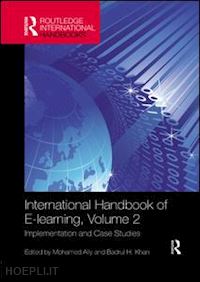Preface Forward Acknowledgements About the Editors Contributing Authors Chapter 1: Opening Digital Learning for Deeper Inquiry, Jon Mason and Hitendra Pillay Chapter 2: Using Social Media in the Online Classroom, Lisa Marie Blaschke and Jane Brindley Chapter 3: The integration of educational technology in education and in the workplace: An organizational perspective, Claude Martel Chapter 4: Mobile learning in higher education: Current status and future possibilities, Yasemin Gulbahar, Carolyne Jacobs, and König Andreas Chapter 5: Media-Based Learning Methodology: Stories, Games, and Emotions, Prof. Dr. habil. Hans W. Giessen Chapter 6: A Case of Distance Education through Social Network Sites, Giovanni Farias Chapter 7: Multimedia production projects: relevant issues and possible models for mobile learning, Izabel de Moraes Sarmento Rego, Joni de Almeida Amorim, and Per M. Gustavsson Chapter 8: Learners of Digital Era (LoDE): What’s true, and what’s just hype about the so-called digital natives, Emanuele Rapetti and Lorenzo Cantoni Chapter 9: Blended Learning in Higher Education, Fayiz M. Aldhafeeri Chapter 10: ePortfolio Development and the Potential Relationship to Learning Theories, Anthony Ralston Chapter 11: Development of a context appropriate E-learning site, Tanim Ashraf, Shekh Mohammad Mahbubul Kadir, and Sanjib Saha Chapter 12: Education’s Second Life: Virtual Learning in Higher Education, Shelagh McGarth and Carlo M. Trentadue Chapter 13: Lifelong Learners and Teachers’ Time Management Competency in E-learning, M. Romero and E. Barberà Chapter 14: Library Support for Online Learners, Katherine M. Tyler Chapter 15: 2D and 3D virtual environments: communication potentialities for E-learning education, Tatiana Stofella Sodré Rossini and Edméa Oliveira dos Santos Chapter 16: Open and Virtual Universities Worldwide, Susan Bainbridge and Mohamed Ally Chapter 17: E-learning and mobile learning development in the State of Qatar, Martha Robinson, Mohamed Ally, and Mohammed Samaka Chapter 18: Implementing Mobile Learning Devices into Tertiary Classrooms: A UAE Case Study, Troy Priest and Kevin Schoepp Chapter 19: E-learning Implementation at an Open University: The case of Universitas Terbuka (The Indonesia Open University), Dewi Padmo and Sri Harijati Chapter 20: Maximizing Study Hours with Cloud and Mobile Based E-learning: A case study at a full-online university in Japan, Hiroshi Kawahara, Miwako Nogimori, and Sayaka Matsumoto Chapter 21: E learning in India, Ramesh C. Sharma and Sanjaya Mishra Chapter 22: Using mobile phones for teacher professional development in Bangladesh: Views of secondary school teachers and teacher facilitators, Robina Shaheen and Ashok Paul Kumar Chapter 23: Managing the change during E-learning integration in Higher Education: A case study from Saudi Arabia, Khalid Alshahrani and Len Cairns Chapter 24: Issues and Implications of Integrating E-learning at Arab Universities, Ali Al-Musawi and Mary Lane-Kelso Chapter 25: E-learning for Continuing and Professional Development, Angela Kwan and Mary Wilson Chapter 26: Using the Unified Theory of Acceptance and Use of Technology and Dewey’s Theory of Experience to Interpret Faculty Experience of E-learning at One School of Public Health, Terry Kidd and Jean Madsen Chapter 27: A Blended Learning Approach to Team-Oriented Work in Large Classes: A Facebook Case Study, Salys Sultan Chapter 28: Mobile Learning BYOD implementation in an Intensive English Program, Rasha Alokaily Chapter 29: Blended Learning and Teaching - a Panacea for Students with Learning Disabilities, Edith Gotesman Chapter 30: Supporting student engagement in E-learning in a resource constrained institution: experiences from Makerere university, Michael Walimbwa Index











